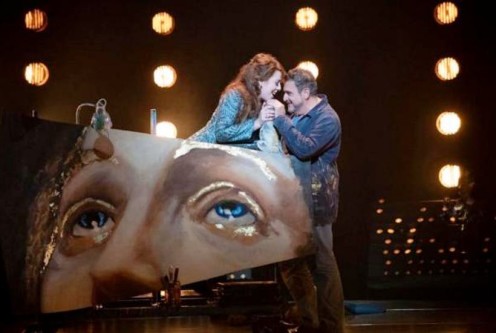 United Kingdom Puccini, Tosca: Chorus and Orchestra of Opera North / Jonathan Santagada (conductor). The Lowry Theatre, Salford Quays, 14.11.2018. (RJF)
United Kingdom Puccini, Tosca: Chorus and Orchestra of Opera North / Jonathan Santagada (conductor). The Lowry Theatre, Salford Quays, 14.11.2018. (RJF)

Cast:
Floria Tosca – Giselle Allen
Mario Cavaradossi – Rafael Rojas
Baron Scarpia – Robert Hayward
Cesare Angelotti – John Savournin
Spoletta – Rupert Charlesworth
Production:
Director – Edward Dick
Set designer – Tom Scutt
Costume designer – Fotini Dimou
Lighting designer – Lee Curran
Choreographer – Maxine Braham
Opera North celebrated its thirtieth anniversary with a reprise of an earlier Christopher Alden production of Tosca whose set by Charles Edwards looked like the junk outhouse of a church with its sacristy, full of clutter including a statue of the Madonna, a confessional, assorted chairs and tea-making equipment as well as Cavaradossi’s paint gear. It was stark and perhaps meant to outline the brutality of the story. Alden seemed not merely content to outline that brutality, but to underline it in the décor, if I could call it that. This extended to the adjacent office of the sacristan who smoked his day away watching TV or selling lottery tickets throughout all three acts without an outward glance of the rape and murder going on outside his window! (For a review click here.)
Thankfully, Edward Dick’s new Tosca production (to celebrate Opera North fortieth anniversary) consigns Alden’s effort, or aberration, to history and has sets by Tom Scutt. Updating is the name of the game, but at least the set is decorative, albeit I did not like the idea of Act II being played in Scarpia’s bedroom with his lusting of Tosca involving scampering over his angle iron framed bed. Given the propensity of the character’s sadism, I suppose it is feasible that Tosca would find a knife, conveniently placed, on an adjacent table. Most obvious in that act, is the reinforcement of the updating by the presence of a laptop used by Scarpia to show Tosca the torturing of Cavaradossi. Smart phones were also in full view as the sadist’s henchmen communicated with the torture chamber.
We only saw the sacristan when it was appropriate, particularly after the arrival of Angelotti, via rope, from the open topped and elegantly decorated cupola, which in Act III, was tilted to the horizontal and from which Tosca jumps to her death. Not quite like Castel Sant’Angelo, but effective, particularly when aided by brilliantly bright stage lighting at that point. The Act I staging with twinkling lights around the church as Cavaradossi’s painting is wheeled about is effective and atmospheric, the lights being also present later. As to the Act III staging of the arrival of Cavaradossi for his execution, I felt it lost a little impact in the manner of its visual presentation of him in the middle of the stage. However, overall, I found the staging and musical contributions to be of excellent impact dramatically, and after all, that is what matters in an operatic production. This staging will last Opera North well I suggest.
On the musical side the orchestral playing under Jonathan Santagada was quite outstanding. His tempi and modulation of the orchestral forces, and support for his singers, could hardly be better. Of the singing cast two had been involved in the Alden production ten years ago, both Opera North regulars, a pleasing habit of the company. First to be heard was Rafael Rojas who last season as Riccardo in Verdi’s Un ballo in maschera (for review click here) where I found his singing to be coarse, often loud and lacking vocal elegance in failing to caress Verdi’s phrases. This time round he brought plenty of heft to ‘Recondita armonia’ in Act I and vocal sensitivity in his treatment of Tosca as she suspected him of double timing her with the lady in his painting on the easel. His cries of ‘Vittoria! Vittoria!’ in Act II had plenty of agonised heft whilst his singing of ‘E lucevan le stelle’ was ideal in its sensitivity of tone and expression. It reminded me very much of his younger days with the company. Robert Hayward’s Scarpia has also weathered well. Looking back at my criticism then, it is mirrored in this performance this time too. An extra depth of darker tone and physical demeanor would add to a more saturnine impact, particularly in Act I.
Most important of all to the cast is the capacity of the singer playing the eponymous role. I have seen a lot of different sopranos as Tosca, both live and on film. Giselle Allen matches the very best I have seen both as singer and actress. Her phrasing, subtle changes of dynamic and vocal characterisation mark out the superb quality of her interpretation, which is, in simple terms, world-class. We are fortunate, privileged, to have seen her consummate interpretation in this performance.
Robert J. Farr
